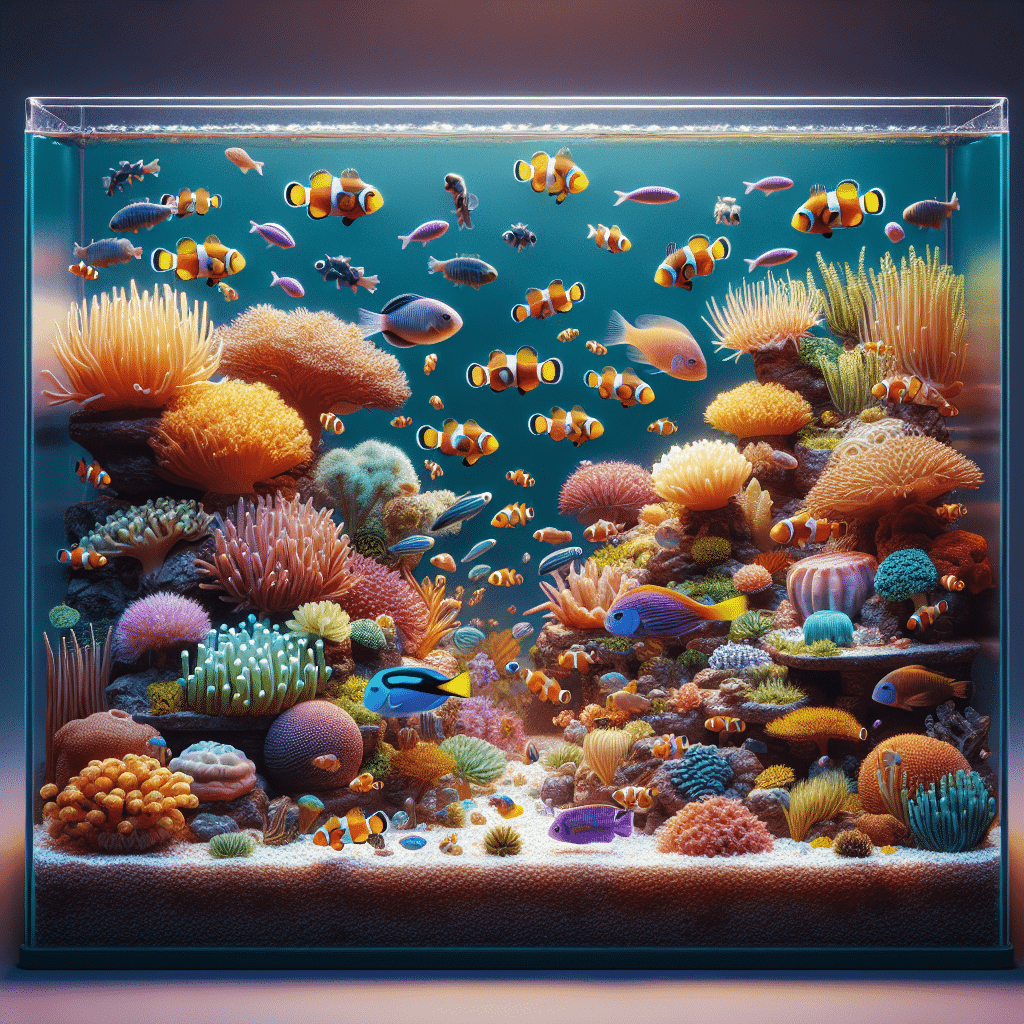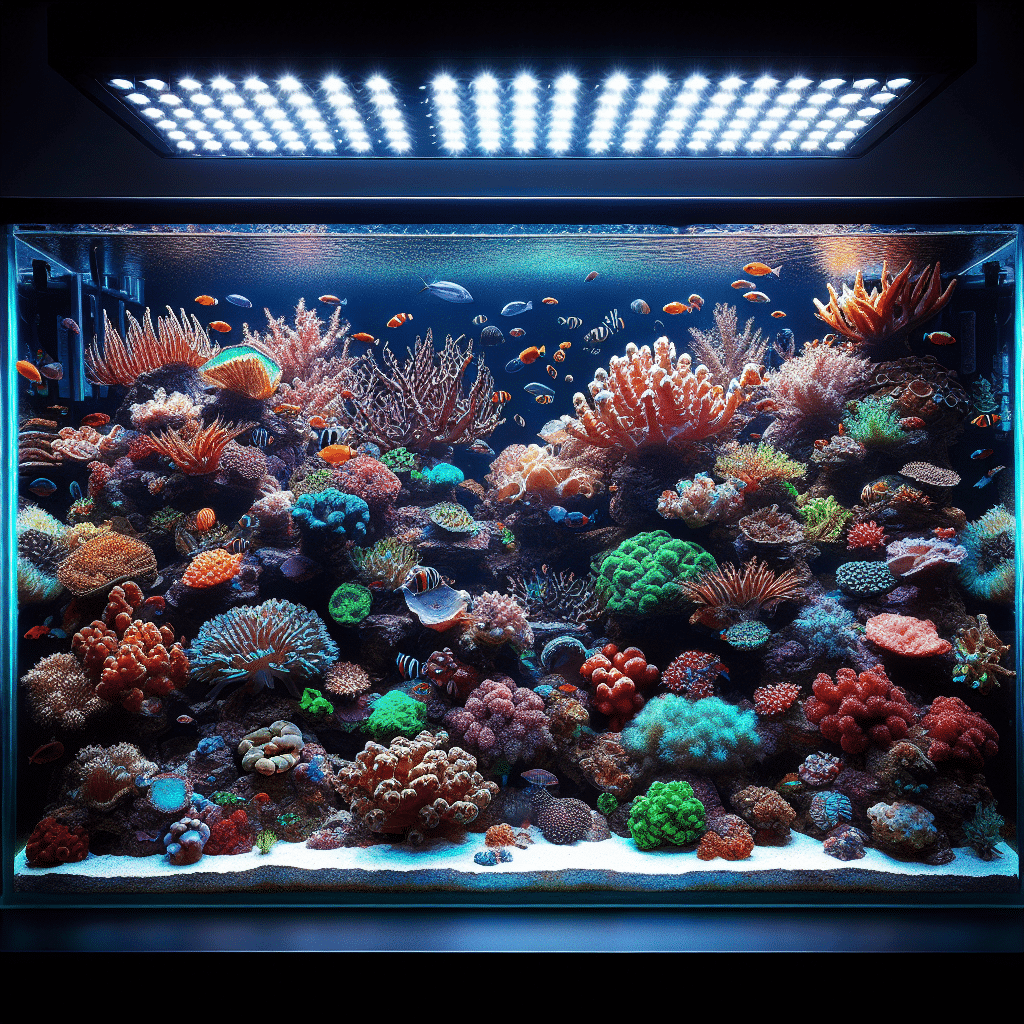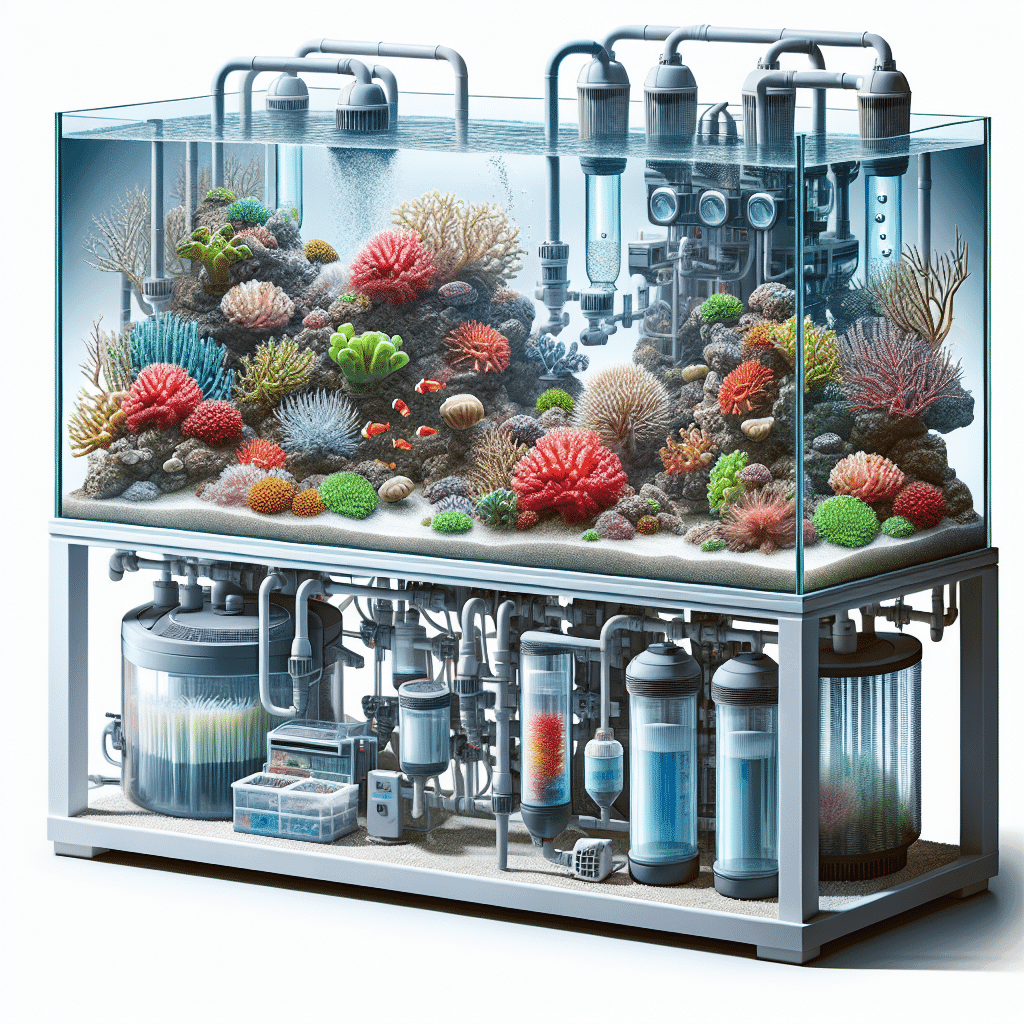Nano Reef Tank Basics
Understanding the fundamentals of nano reef tanks is essential for anyone interested in creating a vibrant aquatic environment. This section will define what a nano reef tank is and explore its numerous benefits.
Definition and Characteristics
Nano reef tanks are typically defined as aquariums with a capacity of 30 gallons or less, although the term is often used for tanks smaller than 40 gallons. These smaller systems have gained popularity in the marine hobby, transitioning from a niche interest to a mainstream trend. The compact size of nano reef tanks brings unique considerations, making them an excellent choice for beginners (Reef2Reef, TFH Magazine).
| Tank Size | Description |
|---|---|
| Less than 15 gallons | Traditionally considered nano reef tanks |
| 15 – 30 gallons | Gaining popularity among hobbyists |
| 30 – 40 gallons | Often included in the nano category |
Benefits of Nano Reef Tanks
Nano reef tanks offer several advantages that appeal to both beginners and experienced aquarists. Some notable benefits include:
- Lower Cost: Smaller tanks generally require less equipment and fewer materials, making them more affordable to set up and maintain.
- Space Efficiency: Nano reef tanks can fit in smaller spaces, making them ideal for apartments or homes with limited room for larger aquariums.
- Diverse Coral Options: These tanks allow for the housing of corals that may not be suitable for larger systems, such as zooxanthellae-dependent organisms (TFH Magazine).
- Easier Maintenance: Smaller volumes of water can be easier to manage, allowing for quicker cleaning and water changes.
- Convenience of All-in-One Setups: Many nano reef tanks come as all-in-one systems with built-in filtration and lighting, providing a convenient and affordable option for enthusiasts.
By understanding these fundamentals, individuals can make informed decisions regarding their nano reef tank fish selection and overall setup. For more details on setting up a nano reef tank, visit our page on nano reef tank setup.
Essential Equipment for Nano Reef Tanks
Setting up a nano reef tank requires careful selection of equipment to ensure a thriving aquatic environment. This section covers the essential components needed for a successful nano reef tank setup.
Aquarium Setup
The first step in establishing a nano reef tank is selecting the right aquarium. A typical nano reef tank ranges from 5 to 30 gallons. Essential items needed for a proper setup include:
- Aquarium: Choose a size that fits your space and desired aesthetic.
- Powerhead or Wave Maker: These devices create water movement, which is beneficial for corals and fish.
- Refractometer: This tool measures the salinity level of the water.
- Quality Reef Lighting: Proper lighting is essential for coral health and growth.
- Sand or Bare Bottom: Decide whether to use substrate for aesthetics or go bare bottom for easier maintenance.
- RO/DI Water or Distilled Water: Use purified water to prevent contaminants.
- Live Rock: Provides biological filtration and habitat for marine life.
- Filter: Essential for maintaining water quality.
- Heater: Keeps the water at a stable temperature.
For more information on setup, explore our article on nano reef tank setup.
| Equipment | Purpose |
|---|---|
| Aquarium | Housing aquatic life |
| Powerhead/Wave Maker | Water circulation |
| Refractometer | Measures salinity |
| Reef Lighting | Supports coral growth |
| Live Rock | Biological filtration |
Water Parameters and Testing
Maintaining stable water parameters is crucial for the health of both fish and corals in a nano reef tank. Regular testing of the following parameters is recommended:
- Salinity: Ideal range is typically between 1.023 and 1.025 specific gravity.
- Temperature: Maintain between 75�F and 80�F (nano reef tank temperature).
- pH Levels: Aim for a pH of 8.1 to 8.4.
- Ammonia, Nitrite, and Nitrate Levels: Monitor these levels to ensure a safe environment.
Utilizing test kits and monitoring equipment is essential for keeping track of these parameters. For detailed guidance on testing, refer to our article on nano reef tank maintenance.
Filtration Systems
Filtration is vital to maintain water quality in nano reef tanks, which often have limited water volume. A good filtration system helps remove debris and toxins. Key components include:
- Biological Filtration: Utilizing live rock and beneficial bacteria to break down waste.
- Chemical Filtration: Activated carbon or other media to remove impurities.
- Mechanical Filtration: Foam filters to physically remove particles and debris.
Nano reef tanks may also benefit from installing a protein skimmer, which efficiently removes organic waste before it breaks down. While affordable options exist, investing in quality components can lead to better tank stability and fish health. For more on filtration options, check our article on nano reef tank filtration.
| Filtration Type | Purpose |
|---|---|
| Biological | Breaks down waste |
| Chemical | Removes impurities |
| Mechanical | Clears debris |
Choosing the right equipment and maintaining optimal water parameters are essential steps in creating a successful nano reef tank. By investing in quality components and regularly monitoring conditions, hobbyists can enjoy a vibrant aquatic environment filled with beautiful fish and corals.
Selecting Fish for Nano Reef Tanks
Choosing the right fish for a nano reef tank is crucial for creating a harmonious and thriving aquatic environment. This section explores compatible nano fish species and important considerations in the selection process.
Compatible Nano Fish Species
When selecting fish for a nano reef tank, it is essential to choose species that can coexist peacefully and adapt to the smaller environment. Some of the best nano fish suitable for these tanks include:
| Fish Species | Characteristics |
|---|---|
| Basslets | Vibrant colors, generally peaceful |
| Blennies | Fun personalities, good algae controllers |
| Cardinalfish | Peaceful, often found in schools |
| Chromis | Active swimmers, add movement to the tank |
| Clownfish | Hardy, establish symbiotic relationships with anemones |
| Gobies | Small size, excellent for sand substrates |
| Wrasses | Colorful, active, and beneficial for pest control |
In addition to fish, consider incorporating invertebrates that are suitable for nano reef environments, such as zoanthids, peppermint shrimps, small hermits, and snails (TFH Magazine). Each species brings unique characteristics that contribute to the overall ecosystem.
Considerations for Fish Selection
Selecting fish for a nano reef tank involves several important factors to ensure compatibility and health:
Compatibility: It is vital to choose fish and invertebrates that can coexist without aggression. Some species, like fairy wrasses and cardinals, are known to thrive in smaller setups without territorial disputes.
Space Requirements: Nano tanks have limited space, making it necessary to select species that do not require extensive swimming room. Overcrowding can lead to stress and aggression among tank inhabitants.
Water Parameters: The small water volume of nano reef tanks makes them more susceptible to rapid fluctuations in parameters, such as temperature and salinity. Regular monitoring of nano reef tank temperature is essential to maintain stability and prevent harm.
Feeding Practices: Proper feeding is crucial to avoid overfeeding, which can lead to water quality issues. A well-structured feeding schedule helps maintain the health of both fish and corals.
By carefully selecting compatible fish species and considering their specific needs, aquarists can create a thriving and beautiful nano reef tank. For more insights on setting up your aquarium, refer to our guides on nano reef tank setup and nano reef tank maintenance.
Setting Up and Maintaining a Nano Reef Tank
Setting up and maintaining a nano reef tank requires careful planning and consistent effort. Following the right steps ensures a thriving environment for fish and corals.
Tank Cycling Process
Before introducing any inhabitants, it is crucial to cycle the tank. This process allows the aquarium to establish beneficial bacteria that convert harmful ammonia from fish waste into less toxic nitrites, and then into nitrates. Following this nitrogen cycle is essential for maintaining a healthy environment.
- Initial Setup: Fill the tank with saltwater and set up all necessary equipment.
- Monitor Ammonia Levels: Initially, ammonia levels will rise as waste accumulates.
- Nitrite and Nitrate Production: Once ammonia peaks, beneficial bacteria will begin converting it into nitrites, which will eventually turn into nitrates.
- Cycle Duration: This cycling process typically takes 4 to 6 weeks.
It is recommended to let the tank cycle thoroughly before adding any snails, crabs, or fish to the tank (Nano-Reef).
Adding Inhabitants Carefully
After the tank has cycled, the next step is to add inhabitants. It is advisable to start with hardy species, such as snails and crabs, before introducing fish and corals.
| Inhabitant Type | Recommended Order |
|---|---|
| Snails & Crabs | First |
| Fish | Second |
| Corals | Last |
To avoid overstocking, limit additions to two new inhabitants per week. This gradual approach helps maintain a healthy balance in the tank.
Regular Tank Maintenance
Regular maintenance is vital for the health of a nano reef tank. This includes:
- Partial Water Changes: Conduct partial water changes every two weeks, or more frequently if necessary.
- Monitor Water Parameters: Regularly check pH, ammonia, nitrite, and nitrate levels to ensure they are within safe ranges.
- Observe Inhabitants: Look for signs of disease or weakness among the tank’s inhabitants.
- Equipment Checks: Ensure all equipment, including filtration and lighting, is functioning properly.
For more detailed guidance on maintaining your tank, refer to our article on nano reef tank maintenance. By following these practices, hobbyists can create a thriving ecosystem in their nano reef tanks.
Challenges and Considerations for Nano Reef Tanks
Maintaining a nano reef tank presents unique challenges that require careful planning and management. From water stability to feeding practices, understanding these challenges is essential for success.
Stability in Water Parameters
In nano reef tanks, maintaining stability in parameters such as temperature, salinity, pH, and nutrient levels is crucial for the health and well-being of both fish and corals. The small water volume in these tanks makes them particularly susceptible to rapid fluctuations in these parameters. Regular monitoring and maintenance are necessary to prevent stress and harm to the tank inhabitants (Reef2Reef).
| Parameter | Ideal Range |
|---|---|
| Temperature | 75�F – 80�F |
| Salinity | 1.023 – 1.025 SG |
| pH | 8.1 – 8.4 |
| Nitrates | < 5 ppm |
| Phosphates | < 0.03 ppm |
Feeding Practices
Proper feeding practices are essential in nano reef tanks to avoid overfeeding, which can lead to water quality issues and negatively impact the health of the fish and corals. It’s important to feed small amounts that can be consumed within a few minutes. Any uneaten food should be promptly removed to maintain water quality.
| Fish Type | Recommended Feeding Frequency |
|---|---|
| Small Tropical Fish | 2-3 times a day |
| Corals | 1-2 times a week (depending on type) |
Overcoming Size Limitations
The limited space in nano reef tanks can pose challenges, particularly regarding stocking density and equipment. It is vital to avoid overcrowding the tank with both fish and corals, as this can lead to increased competition for resources and stress among inhabitants. Selecting compatible fish species and carefully planning tank setup can help mitigate these issues. Essential components for maintaining water quality include biological, chemical, and mechanical filtration systems (TFH Magazine).
To ensure a balanced environment, tank owners should focus on quality equipment without overcrowding the tank with unnecessary items. Essential components include heaters, thermometers, GFI power strips, test kits, and protein skimmers, which are vital for maintaining a healthy ecosystem.
By addressing these challenges and considerations, nano reef tank enthusiasts can create a thriving aquatic environment that brings joy and beauty to their space. For more insights on optimizing your nano reef tank, explore our articles on nano reef tank setup and nano reef tank maintenance.
Advanced Tips for Nano Reef Tank Success
Creating a thriving nano reef tank requires careful planning and consideration, especially when it comes to coral compatibility, efficient filtration systems, and stocking recommendations. Here are some advanced tips to ensure success in maintaining a nano reef environment.
Coral Compatibility
Nano reef tanks provide opportunities to house corals that may not be suitable for larger setups. Corals such as zooxanthellae-dependent organisms are ideal for these smaller environments. All-in-one setups equipped with strong lighting and efficient filtration systems are recommended for nano reef tanks, making them an affordable and convenient option for enthusiasts (TFH Magazine).
When selecting corals for a nano reef, it is crucial to consider their compatibility with fish and other invertebrates. Below is a table listing some compatible coral species:
| Coral Type | Compatibility |
|---|---|
| Zoanthids | High |
| Soft Corals | High |
| LPS Corals | Moderate |
| SPS Corals | Low |
Efficient Filtration Systems
Maintaining water quality in a nano reef tank is essential, particularly due to the limited volume of water. Nano reef tanks require biological, chemical, and/or mechanical filtration to ensure a stable environment. Components such as protein skimmers, filters, and quality lighting are critical for the health of the tank. While there are affordable options available, investing in quality components may yield better results in the long run.
| Filtration Type | Importance Level |
|---|---|
| Biological Filters | High |
| Chemical Filters | Moderate |
| Mechanical Filters | High |
| Protein Skimmers | Very High |
For more information on filtration systems, check out our article on nano reef tank filtration.
Stocking Recommendations
Selecting the right fish and invertebrates for a nano reef tank is crucial for maintaining harmony within the ecosystem. It is essential to choose species that are compatible with the tank size. Recommended fish species include fairy wrasses, grammas, cardinals, gobies, dartfishes, and some damselfishes. For invertebrates, consider adding zoanthids, peppermint shrimps, small hermit crabs, and snails (TFH Magazine).
Below is a table summarizing recommended species for stocking:
| Fish/Invertebrate | Size Compatibility |
|---|---|
| Fairy Wrasses | Small |
| Grammas | Small |
| Cardinals | Small |
| Gobies | Small |
| Zoanthids | Small |
| Peppermint Shrimps | Small |
For further guidance on stocking your tank, visit our article on nano reef tank stocking.
These advanced tips will help ensure a successful and vibrant nano reef tank, providing a beautiful underwater habitat for both fish and corals.



